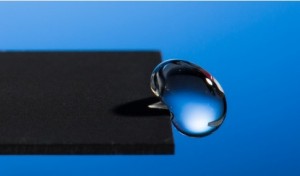Water-repellent self-cleaning metals
Lasers Help Metal Resist Rust and Ice – using lasers, researchers at the University of Rochester have developed a way of “creating micro- and nanoscale structures” on the surface of metals that renders them hydrophobic; water simply bounces off metals treated in this way.
The link above takes you to an interview on Science Friday with one of the researchers working on this technology, physicist Chuniel Guo of the University’s Institute of Optics. Dr. Guo speaks of possible application to airplane wings and tail to prevent icing and the work his lab is doing with the Bill & Melinda Gates Foundation on toilet surfaces that would use less water and be easier to keep clean. He mentions, too, that they’ve been working on making surfaces oil-repellent.
In a study just published in the Journal of Applied Physics, Guo and co-author Vorobyev describe the treated metal surface as ‘multifunctional’ and also as being self-cleaning.
The superhydrophobic effect is demonstrated by a falling water droplet repelled away from a structured surface with 30% of the droplet kinetic energy conserved, while the self-cleaning effect is shown by each water droplet taking away a significant amount of dust particles on the altered surface. The multifunctional surface is useful for light collection and water/dust repelling.
The U of Rochester’s press release says this about a possible solar energy application (lasers can be used to turn metals black):
Guo is keen to stress that this same technique can give rise to multifunctional metals. Metals are naturally excellent reflectors of light. That’s why they appear to have a shiny luster. Turning them black can therefore make them very efficient at absorbing light. The combination of light-absorbing properties with making metals water repellent could lead to more efficient solar absorbers – solar absorbers that don’t rust and do not need much cleaning.
Gizmodo has fun video of water bouncing off of the treated metal; this one is especially good at highlighting the treated metals’ characteristics. For media coverage of the lab’s related work, check out the High-Intensity Femtosecond Laser Laboratory website.

